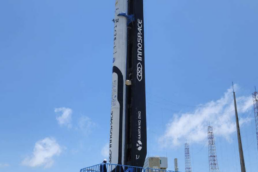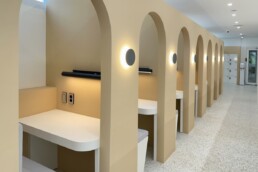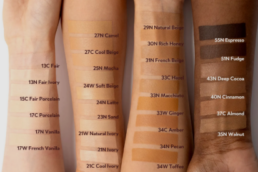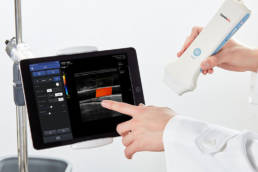Gamma rays are beams of radiation emitted by breaking down the nuclei of radioactive atoms. Therefore, gamma-ray cameras (gamma cameras) can be used in many industries such as nuclear medicine, homeland security, food safety, and more. However, traditional gamma-ray cameras for imaging require a large machine that scans the whole body and often occupies the majority of exam rooms. In addition, it offers low resolution, low expandability, and is very expensive. This is why many startups are looking into creating portable gamma-ray cameras that are just as efficient, while at the same time being affordable.
Medical startup ARALE Laboratory has created the smallest and lightest portable gamma-ray camera. The gamma-ray camera is small enough to fit in the palm of your hand. In real-time, the portable gamma-ray camera can detect and localize hot spots and identify visually the source of gamma radiation. By significantly reducing the size of gamma-ray cameras and making them portable, gamma-ray technology can be applied to many industries not just in nuclear medicine.
Portable Gamma-Ray Cameras for the Medical Industry
By far, the industry that can benefit the most from portable gamma-ray cameras is the medical industry. Gamma-ray imaging is often referred to as nuclear imaging and it assesses how organs look. Therefore, they are more efficient for physicians to make a proper diagnosis and plan for treatment. It is commonly used for early cancer detection.
Gamma rays can be emitted in different ranges such as the same range as an X-ray. Radioactive tracers are injected into a patient and it then travels throughout the area being examined. These radioactive tracers accumulate in tumors or areas of high inflammation. Then it gives off small amounts of energy in the form of gamma rays which can be detected by gamma-ray cameras. The gamma-ray cameras can be combined with a smartphone/tablet/computer to create a visual representation of what is occurring inside the body. SPECT (Single Photon Emission Computed Technology) works together with the gamma-ray camera and uses low-energy gamma-rays less than 400 kilo-electron volts (keV) to detect radioactive tracers emitting from the patient.
Portable gamma-ray cameras like the one developed by ARALE offer physicians flexibility as well as more detailed 3D images through SPECT. The gamma-ray camera itself does not emit any radiation but rather is composed of radiation detectors. When combined with SPECT, it can produce more detailed 3D images. This allows physicians to potentially identify diseases in their early stages. Therefore, physicians can identify diseases before they may be seen on other imaging tests. This process is both noninvasive and painless aside from the injection. In addition, it can not only detect certain types of cancers but also heart disease, neurological disorders, and other abnormalities. Lastly, it can be used to see if a patient’s body is responding to a particular treatment.
Portable Gamma-ray Cameras in Homeland Security

Terrorist attacks are a constant concern for many governments. While diplomacy is a major deodorant for terrorism, there should always be a backup plan. Most of the radioactive materials used for creating nuclear and dirty bombs emit gamma rays. However, nuclear bombs are not commonly used by terrorists because they require a high level of technology. Dirty bombs on the other hand are a major problem for Homeland Security because these bombs are relatively easy to make and can be small enough to fit in a small bag. The impact of a dirty bomb can cause significant damage.
Airport Security
Airports today mainly rely on high-powered X-rays. However, they only offer a 2D projection of the shapes of objects inside bags, suitcases, and containers. Therefore, denser objects could potentially have a nuclear threat that needs to be physically opened for inspection. These inspections for each cost airports time and resources. In addition, it can be highly dangerous if in fact there is a bomb inside the object.
Gamma-ray cameras can identify any radioactive material that may signal a nuclear/dirty bomb. Therefore, only those that give off radioactive materials can be checked which will cut down both time and cost for airports and focus their attention on high-risk bags/containers.

Portable gamma-ray cameras can collect radiation data in real time and wirelessly connect to smartphones/tablets/computer systems. Staffers can carry the detectors with them as they monitor the airport. If the detector identifies gamma radiation, it can then send a digital signal to the security command center. The portable gamma-ray camera was developed by ARALE. It can be installed at airports since it has a smart-zoom radiation monitoring system that can focus and zoom in on a particular object. Furthermore, thanks to its small size, it can be attached to drones in order to scan large crowds and shipping containers. Moreover, the photon counting technology that has been applied in this gamma camera can analyze the energy level and type of radiation. Using this information, the baggage scanners can be smart enough to hunt out not only radioactive materials but also explosive materials.
Portable Gamma-ray Cameras for Nuclear Power Plant Inspection
The biggest issue for nuclear power plants and nuclear waste repositories is finding and identifying radiation leakage. Therefore, portable gamma-ray cameras are perfectly suited for the nuclear power industry. Inspectors can quickly identify and find the direction and character of the leak. It can also be used to determine whether or not a particular shield is effective. Traditionally, physical samples need to be collected from multiple sources to identify the contamination. This is one of the most important technologies in the nuclear power plant decommissioning industry. For example, for the Fukushima decontamination project, several types of heavy and bulky gamma cameras were used to identify the radioactive hot spots. The compactness of portable gamma cameras will make this process not only quicker but more versatile.
Related Posts







